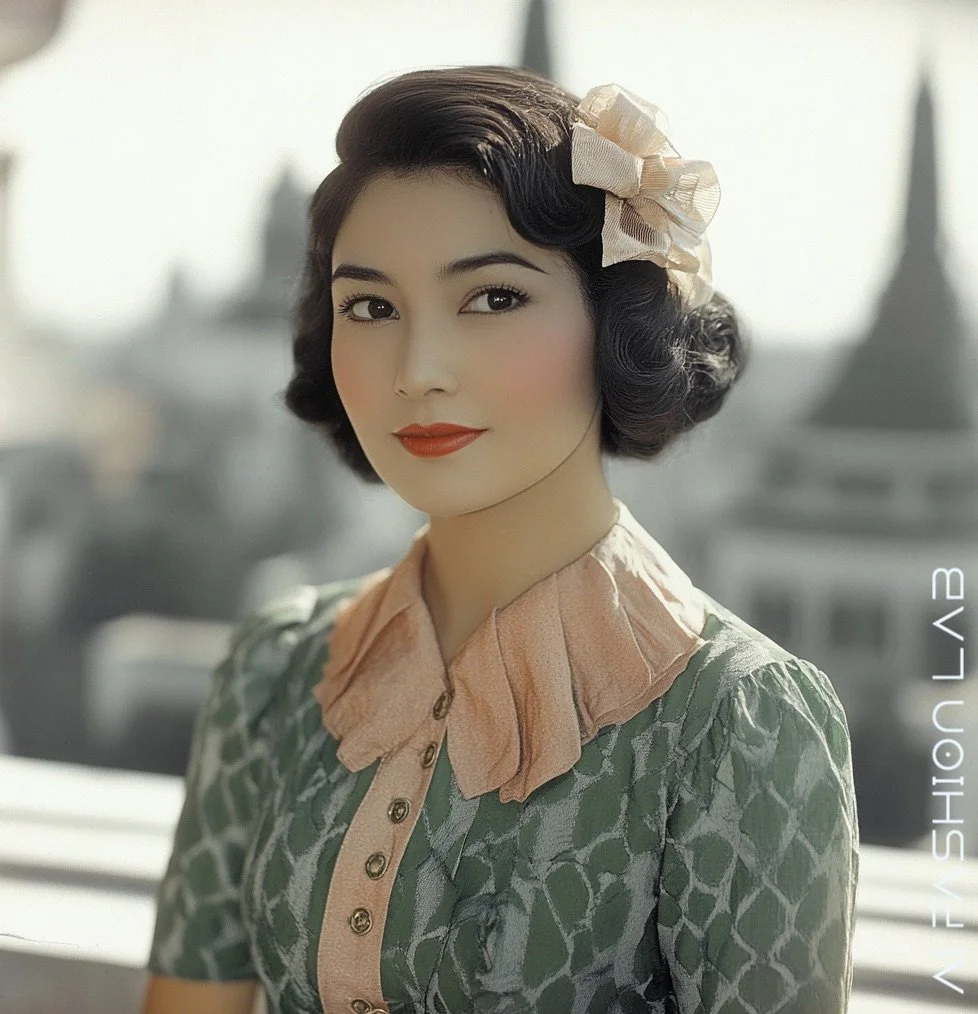1930s Thai Fashion: Auspicious Colours Paired with Western Collars
The images bring a unique cultural touch by incorporating Thailand’s traditional “auspicious dual colours” for each day of the week, a practice rooted in the royal inner court traditions from the reign of King Chulalongkorn.
Fashion in 1930s Thailand During the Reign of King Rama VII: The Influence of Western Style and Traditional Colours
In the 1930s, during the reign of King Rama VII, Thailand experienced significant influence from Western fashion, with the upper class, especially in urban areas, embracing Western attire. The transformation was evident in both the design of clothing and the details, particularly the collars, which became an essential element in defining sophistication and elegance. As collars like the Peter Pan, winged, and Windsor styles became popular in the West, they began to make their way into Thai fashion, especially among those looking to present a modern, refined image.
This article accompanies a collection of vintage-inspired photographs that I created, using 1930s Western collar styles as the focus. To add a Thai cultural layer, I chose to colourise these black-and-white images based on the concept of auspicious dual colours traditionally worn by ladies of the inner court during the reign of King Chulalongkorn (Rama V). Each day of the week was associated with specific auspicious colour combinations that were believed to bring good fortune and were carefully chosen to reflect the wearer’s status and elegance. This concept has been applied to the images in the collection, where each piece is colourised with these dual tones to blend Western-inspired collars with Thai cultural aesthetics.
In this collection, the shawl or สไบ (sabai) is used as a key feature to represent traditional Thai elements. The sabai is a wrap that women traditionally draped around the chest and back, serving both as decoration and modesty. Often, one end of the sabai would be brought over the shoulder, in a style known as สไบเฉียง (sabai chiang), which adds an asymmetrical elegance to the look. By incorporating the sabai in colours inspired by Thai cultural traditions, each photograph pays homage to the fusion of Thai and Western aesthetics.
Auspicious Colour Combinations for Each Day of the Week
Here is the colour concept I used, based on traditional auspicious colours in Thai culture, which guided the pairing of the skirt and sabai in each photograph:
Monday:
Skirt in light yellow with sabai in light blue or fuchsia.
Alternatively, if the skirt is in pigeon blue, the sabai should be in dark champak red.
Tuesday:
Skirt in mortar (a greyish-white) or deep plum (purple of marian plum seed) with sabai in asoke green (similar to olive green).
Alternatively, if the skirt is in asoke green or light green, the sabai should be in light purple.
Wednesday:
Skirt in pea green or iron grey with sabai in champak yellow.
Thursday:
Skirt in leaf green with sabai in bird-blood red (a dark red).
Alternatively, if the skirt is in bright orange, the sabai should be in light green.
Friday:
Skirt in dark blue with sabai in yellow.
Saturday:
Skirt in marian plum (deep plum colour) with sabai in asoke green.
Alternatively, if the skirt is in purple brocade, the sabai should still be in asoke green.
Sunday:
Can be styled similarly to Thursday with a skirt in green and sabai in red.
Alternatively, a skirt in lychee or oxblood red (maroon) can be paired with a sabai in asoke green.
This colour concept has been carefully selected to complement each photograph in the collection, highlighting both the elegance of 1930s Western collar designs and the richness of traditional Thai colours. By blending these elements, the collection captures a unique fusion of East and West, vintage charm, and cultural depth, honouring the beauty of Thai heritage while embracing the sophistication of Western fashion trends from the 1930s.
ประวัติศาสตร์แฟชั่นไทยในทศวรรษ 1930 ในรัชกาลที่ ๗: อิทธิพลจากสไตล์ตะวันตกและสีมงคลแบบไทย
ในทศวรรษ 1930 ระหว่างรัชกาลที่ ๗ ประเทศไทยเริ่มได้รับอิทธิพลจากแฟชั่นตะวันตกอย่างมาก โดยเฉพาะในกลุ่มชนชั้นสูงและคนในเมืองที่เริ่มหันมาสวมใส่เสื้อผ้าแบบตะวันตก การเปลี่ยนแปลงนี้เห็นได้ชัดทั้งในรูปแบบการแต่งกายและรายละเอียด เช่น ปกคอเสื้อที่กลายเป็นองค์ประกอบสำคัญในการเพิ่มความสง่างามและดูมีระดับ เมื่อปกคอแบบปีเตอร์แพน ปลายปีก และวินด์เซอร์ได้รับความนิยมในตะวันตก ก็เริ่มแพร่หลายมาสู่แฟชั่นไทย โดยเฉพาะในกลุ่มคนที่ต้องการนำเสนอภาพลักษณ์ที่ทันสมัยและหรูหรา
บทความนี้ถูกจัดทำขึ้นเพื่อประกอบกับคอลเล็คชั่นภาพถ่ายที่ได้รับแรงบันดาลใจจากภาพวินเทจ ซึ่งผมสร้างขึ้นโดยเน้นที่ดีไซน์ปกคอเสื้อแบบตะวันตกในทศวรรษ 1930 นอกจากนี้ เพื่อเพิ่มความเป็นไทยให้กับภาพ ผมเลือกที่จะลงสีในภาพขาวดำเหล่านี้ตามแนวคิดของสีคู่มงคลตามธรรมเนียมชาววังในสมัยรัชกาลที่ ๕ ซึ่งเชื่อว่าสีของแต่ละวันจะช่วยเสริมโชคลาภและแสดงถึงสถานะและความงดงามของผู้สวมใส่ แนวคิดนี้ได้ถูกนำมาใช้ในการลงสีภาพในคอลเล็คชั่น โดยแต่ละภาพจะถูกจับคู่สีตามคอนเซ็ปต์นี้เพื่อผสมผสานความงดงามแบบตะวันตกและความลึกซึ้งของวัฒนธรรมไทย
ในคอลเล็คชั่นนี้ ผ้าห่มหรือ สไบ (sabai) เป็นองค์ประกอบสำคัญที่สื่อถึงเอกลักษณ์ไทย สไบ เป็นผ้าคลุมที่ผู้หญิงไทยสวมใส่แบบพันรอบหน้าอกและหลัง ซึ่งทำหน้าที่ทั้งเป็นการตกแต่งและเพิ่มความเรียบร้อย มักมีการคลุมปลายผ้าข้างหนึ่งให้พาดเฉียงที่ไหล่หนึ่ง ซึ่งเรียกว่า สไบเฉียง (sabai chiang) ทำให้เกิดความสวยงามแบบไม่สมมาตร โดยการนำเอาสไบสีตามธรรมเนียมไทยมาใช้เป็นแนวทางการลงสี ภาพถ่ายในคอลเล็คชั่นนี้จึงเป็นการแสดงออกถึงการผสมผสานความงดงามระหว่างวัฒนธรรมไทยและตะวันตก
คู่สีมงคลสำหรับการแต่งกายแต่ละวัน
ต่อไปนี้คือแนวคิดสีที่ใช้ ซึ่งอิงตามคู่สีมงคลในวัฒนธรรมไทย โดยสีของผ้านุ่งและสไบในแต่ละภาพจะถูกจัดตามแนวคิดนี้:
วันจันทร์:
นุ่งเหลืองอ่อน ห่มสไบน้ำเงินอ่อน หรือห่มบานเย็น
หากนุ่งสีน้ำเงินนกพิราบ จะห่มสไบสีจำปาแดง
วันอังคาร:
นุ่งสีปูนหรือม่วงเม็ดมะปราง ห่มสไบสีโศก
หากนุ่งสีโศกหรือเขียวอ่อน จะห่มสไบสีม่วงอ่อน
วันพุธ:
นุ่งสีถั่วหรือสีเหล็ก ห่มสไบสีจำปา
วันพฤหัสบดี:
นุ่งสีเขียวใบไม้ ห่มสไบสีแดงเลือดนก
หรือหากนุ่งสีแสด ห่มสไบสีเขียวอ่อน
วันศุกร์:
นุ่งสีน้ำเงินแก่ ห่มสไบสีเหลือง
วันเสาร์:
นุ่งสีเม็ดมะปราง ห่มสไบสีโศก
หรือหากนุ่งผ้าลายพื้นสีม่วง ห่มสไบสีโศก
วันอาทิตย์:
สามารถแต่งแบบวันพฤหัสบดีได้ คือ นุ่งสีเขียว ห่มสไบสีแดง
หรือจะนุ่งผ้าลายพื้นสีลิ้นจี่หรือสีเลือดหมู ห่มสไบสีโศก
แนวคิดสีเหล่านี้ถูกคัดเลือกมาอย่างพิถีพิถันเพื่อเสริมให้ภาพถ่ายในคอลเล็คชั่นดูสง่างามและสะท้อนถึงความงดงามของดีไซน์ปกคอเสื้อแบบตะวันตกในทศวรรษ 1930 และความลึกซึ้งของสีมงคลแบบไทย การผสมผสานองค์ประกอบเหล่านี้ทำให้คอลเล็คชั่นสามารถสะท้อนถึงการผสมผสานระหว่างตะวันออกและตะวันตก ความงามแบบวินเทจ และความลึกซึ้งทางวัฒนธรรม โดยเป็นการให้เกียรติความงดงามของวัฒนธรรมไทย พร้อมกับรับเอาความสง่างามของแฟชั่นตะวันตกในทศวรรษ 1930






















